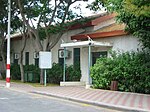Majdal Yaba

Majdal Yaba (Arabic: مجدل يابا) was a Palestinian Arab village in the Ramle Subdistrict, located 18.5 kilometres (11.5 mi) northeast of Ramla and 4 kilometres (2.5 mi) east of Jaffa. A walled Jewish settlement name Migdal Aphek (Hebrew: מגדל אפק, lit. 'Tower of Aphek'; Ancient Greek: Αφεχού πύργος) stood at the same site as early as the second century BCE, and it was later destroyed by the Romans during the First Jewish–Roman War in 67 CE. In the Crusader period, a fort named Mirabel was built at the site. During the Islamic period it became known as Majdal Yaba. For a short time under Ottoman rule, its name was changed from Majdal Yaba to Majdal Sadiq and then back again. Incorporated into Mandatory Palestine in 1922, Majdal Yaba was captured by Israeli forces during the 1948 Arab–Israeli war on July 12, 1948. The town was depopulated as a result of the military assault. The number of refugees from Majdal Yaba was estimated at 1,763. The Israeli locality of Rosh HaAyin was established on the village lands in 1950, followed by the kibbutz Givat HaShlosha in 1953.
Excerpt from the Wikipedia article Majdal Yaba (License: CC BY-SA 3.0, Authors, Images).Majdal Yaba
Sderot Ben Gurion, Rosh HaAyin Mitzpe Afek
Geographical coordinates (GPS) Address Nearby Places Show on map
Geographical coordinates (GPS)
| Latitude | Longitude |
|---|---|
| N 32.080844444444 ° | E 34.956936111111 ° |
Address
מגדל אפק (מגדל צדק)
Sderot Ben Gurion
4851136 Rosh HaAyin, Mitzpe Afek
Center District, Israel
Open on Google Maps










